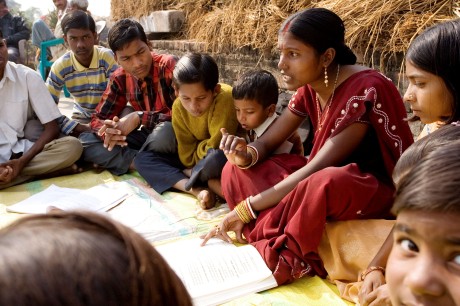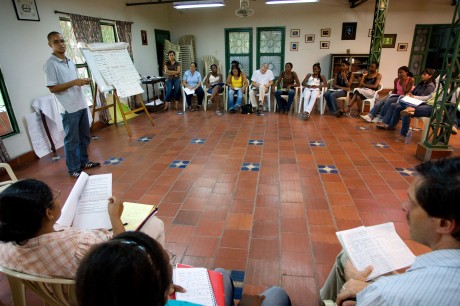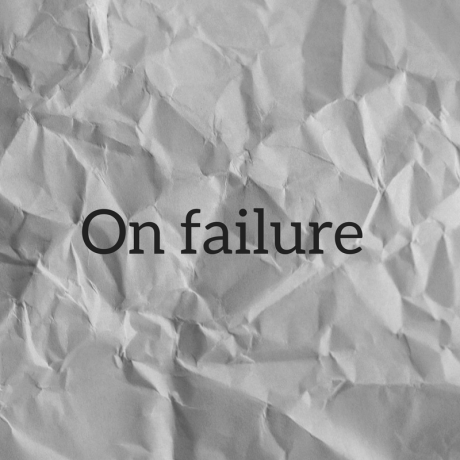
“Scaffolding” is something professional teachers talk a lot about. It’s a simple concept: just like the temporary structure used by builders to provide structure to a wall until it is complete and able to stand on its own, scaffolding in education means the kinds of supports that teachers temporarily put in place to help a child learn a new skill that would otherwise be just out of their range. Rather than letting a child become frustrated with their inability to accomplish something, the teacher provides just enough assistance to get them the rest of the way there. Once the child has done it with help, they are both better prepared and more motivated to learn to do it on their own.
But scaffolding isn’t just for children. If we’re all in a learning mode, then any of us can benefit from this kind of support, even those who are ostensibly teachers.
The nice thing (okay, one of the many nice things) about the Ruhi Institute’s curriculum for children’s classes is that the program grows with the teacher. New teachers start working with a group of 5- and 6-year-olds (or, just as likely in a neighborhood with no children’s class program yet, 5- to 11-year-olds) on the Grade 1 materials. The curriculum is simple at that age: short prayers, repetitive songs, one-sentence quotations, stories that are one to three paragraphs, games with just a couple rules, and basic coloring sheets. Not only is all of this well within the ability of most 5-year-old children, it’s also well within the ability of a new teacher. In Grade 1, everything from what song to sing to what examples to use in illustrating vocabulary words is provided. And tools for tracking basic information like attendance and lessons learned by each child are printed right there in the same book that holds all of these self-contained lessons. Easy breezy, lemon squeezy.
In Grade 2, the children are a little older. They’ve had a bit more experience with the process. Instead of coloring, they’re drawing their own images. Instead of rule-oriented games, they’re working on guideline-oriented theater activities. And instead of each lesson being laid out for a beginning teacher, beginning lesson planning skills come into play, like choosing appropriate songs from a collection that they compile over time.
Grade 3 brings in more academic skills for children, and more extensive planning and organization for teachers. Stories are selected and adapted from historical sources, for example, and dramatic exercises are developed with less guidance from the materials. New skills, like asking questions to check for comprehension, are fully covered in the text so that teachers can learn how to add this component to their classes without worrying yet over the quality of the questions themselves.
I’ve not taught Grade 4, 5, or 6 yet, but it presumably builds both the complexity of the class and the skill of the teacher in a similar way.
Why is this scaffolding of service so robust in the children’s class program? Well, it’s the most highly developed branch course from the main sequence of courses. Many people will study the Grade 1 materials as they climb their way up the trunk of the main sequence of courses of the Ruhi Institute. Teaching children is such a core piece of the community building process that it’s the third book in the sequence. So even people who want to focus on animating junior youth or tutoring older youth and adults will learn the basics of teaching a children’s class, well enough to explain the curriculum to a curious parent or substitute teach as needed. But the real learning comes from those who decide to actually dedicate themselves to the act of teaching. And it’s these folks who will go on to study and teach Grade 2, Grade 3, and so on. It’s a specific branch of learning for those who are devoted to it, but it’s not necessarily meant for everyone.
Right now, there are many branch courses that are offered in different regions or localities as the need emerges. The second book of the main sequence, Arising to Serve, helps people learn to visit friends and share information about the Baha’i teachings with them. In some places, a branch course has emerged, helping those dedicated to home visits learn to share complex information like health and sanitation guidelines. I was lucky enough to be able to study a branch course for raising up academic schoolteachers when I lived in a country where this was an important area of service. But the children’s class program is the only globally-implemented branch course of the Ruhi Institute at the moment, and it has had years to be grown, developed, and refined. The materials themselves have changed quite a lot since I first studied them, and this is a direct result of feedback from teachers around the world.
I don’t know what the next steps are for the development of the Ruhi Institute, aside from the fact that both the main sequence and dedicated branches will continue to grow into a comprehensive and wide-ranging system of distance education spanning the globe. But I am grateful to be able to have faith in the fact that, however our service evolves, we will always find ways to accompany one another, every step of the way.



